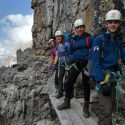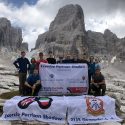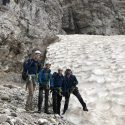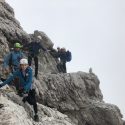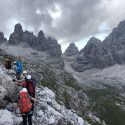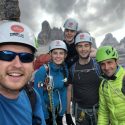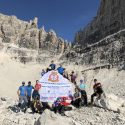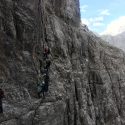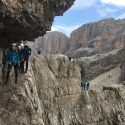Exercise Partisan Shadow was conducted in the Brenta Dolomites in August 2018 and was the culmination of a year’s hard work planning and preparation. This expedition was planned and conducted by three Staff and nine Cadets of 2158 (Sevenoaks) Squadron, Kent Wing Air Cadets, all of whom were given equal opportunities to develop themselves in the lead up to, and during a challenging and exposed international Expedition.
The Expedition was conducted in the shadow of the Partisans, venturing in to the arduous environment that they would have been working in 100 years ago, with the aim of understanding what they experienced helping to defend Italy against the Austro-Hungarian Forces during the First World War. The expedition was planned to coincide with two centenaries, the first being from the End of the First World War, and the second was the formation of the Royal Air Force, The Air Cadets Parent Service.
The expedition was pitched in August 2017 and over the following months all participants undertook multiple climbing sessions on the squadron climbing wall. As part of the training every participant committed to experiencing exposed ridge walks in the Lake District along Striding and Swirrell Edge. On a training weekend we also completed the only Via Feratta course in the UK situated in Honister Slate mine. This introduced them to the method of movement and safety requirements that would be utilised in Italy on the Expedition. On the second May bank holiday the expedition members completed a fund-raising endurance event by completing the 24.5 mile Yorkshire Three Peaks in under the challenge’s 12-hour stipulation. Over these training weekends and sessions, the participants’ skills, confidence and comfort of being in exposed situations increased to the point where they were checking on each other, ensuring that everyone including the staff were suitably prepared.
Early morning mid-August saw the Expedition depart with everything the participants needed for the week packed in to a 35ltr rucksack – ‘hand luggage’ as the staff kept saying! This in itself was a challenge for a few! After a few hours traveling the expedition arrived at the start point in Vallesinella, Madonna di Campiglio. Here there were a few moments to collect water and ensure that kit was stowed before starting off to the overnight accommodation. This first day’s trek was more challenging than many had expected not only because of the heat and humidity but also because of the fact we were starting higher than anywhere in the UK so everything had to be done slower to conserve energy. Once the expedition had arrived at Rifugio Tucket (2268m) the cadets showed their maturity from training by getting themselves squared away ready for the following challenging day.
This second day started with meeting the local guides, who split the expedition down into three teams and conducted their briefs to the groups on the dangers on the routes that we were following. The first day was a challenging introduction to the via ferrata routes with a sheer cliff face to ascend with some precarious rungs. This was preceded and followed by the most beautiful backdrop a first day could consist of. Whilst on route the guide provided an insight in to the partisan activity in the local area, in particular where they helped the Italian troops on a daring positioning of the Hippopotamus (a 6 ton 149G Cannon), across a valley within the Pian di Neve glacier in the Adamello mountain range which we could view on the opposing valley to where we stood. The guide also explained and showed us the effect of climate change on this unique landscape and we could see at first-hand how the glaciers had receded over recent years and rockfalls had occurred due to freeze-thaw action in this dynamic environment. This first day was a sign of things to come and the buzz throughout the teams proved that everyone knew it was only going to get better.
Over the following three days the expedition moved through terrain that The Dolomites has come to be known for, its towering rock chimneys. At times the via feratta route being followed took participants on exposed sections of track that had no fixed cables, sheer drops, slippery steep scree slopes on compact ice, and several stretches of glacial ice to traverse. The circular route was at altitudes in excess of 2000m and a high point of 2936m which was a new experience for the expedition members. It was safe to say that not knowing what the view was going to be like round the next corner was second to ‘what is the next challenge going to be?’
The challenging environment helped strengthen team cohesion and this was particularly evident when the multiple glacier crossings were conducted. We were all roped up together and briefed on movement on the ice, therefore our teamwork needed to be spot on. These challenging environments push everyone out of their comfort zone, Callum Bridel explained that:
“We all had to overcome are own fears and insecurities. Many of us had not been to mountains of this altitude and exposure or with such amazing scenery and certainly had not climbed or stayed overnight at altitude. This presented unique challenges to each of us and pushed us all out of our comfort zones.”
Bradley Relyea, who has a fear of heights, faced one such challenge when he had to descend a 25m ladder which over hung on the rockface half way down, he said that:
“I had no gauge on how long the ladder was, so I just took my time and steadily made my way down. The experience on this ladder solidified that the best thing to do in these situations is to stay calm, stay determined and focus on the task.”
Chas Tate had never completed a mountain day before signing up for the expedition due to a fear of heights from the exposure presented in this environment however:
“It made me realise that I can do anything I set my mind to, helping me overcome fears from the perseverance and support from those people around me.”
Expedition Leader Paul Howes commented that:
“Providing young people with the skills to overcome obstacles is key to the Air Cadets ethos of ‘Venture Adventure’. Watching these young adults, all of whom have an appreciation for adventure, work and live amongst other like-minded individuals is one of the most rewarding things to see. You see the development of characters that you wouldn’t see in a classroom, work together in an environment where everyone’s ability levels are equal with no one having any prior experience. The weather couldn’t have been better for an initial alpine expedition, it allowed the cadets to appreciate the grandeur of the scenery and landscape in which the Partisans fought to defend.”
After descending from the mountain, we had a day exploring Verona and its history. The expedition sought out and visited the key buildings in Verona during the First Wold War. Italy declared war on Austria-Hungary in May 1915 entering WWI on the side of the Allies – Britain, France and Russia. This was due to the terms of the Treaty of London signed in April 1915. Verona was an Austro-Hungarian city at the start of the conflict and held the HQ of The Austrian Field Marshal at Palazzo Carli and the Austrian Army HQ at Palazzo Barbieri. Following a self-guided tour, the rest of the afternoon was R&R with gelato, pizza, pasta and coffee before traveling back to the UK.
We would like to thank all our supporters for the invaluable help they have provided us with on our expedition. Your support has allowed us to give the opportunity to these cadets to experience a challenging mountain environment and adventure that they would not otherwise have been able to access.
Our thanks go to the generosity of the Royal Air Force Charitable Trust for supporting this expedition. www.rafct.com

